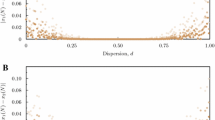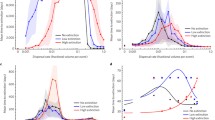Abstract
We propose two methods to control spatial chaos in an ecological metapopulation model with long-range dispersal. The metapopulation model consists of local populations living in a patchily distributed habitat. The habitat patches are arranged in a one-dimensional array. In each generation, density-dependent reproduction occurs first in each patch. Then individuals disperse according to a Gaussian distribution. The model corresponds to a chain of coupled oscillators with long-range interactions. It exhibits chaos for a broad range of parameters. The proposed control methods are based on the method described by Güémez and Matías for single difference equations. The methods work by adjusting the local population sizes in a selected subset of all patches. In the first method (pulse control), the adjustments are made periodically at regular time intervals, and consist of always removing (or adding) a fixed proportion of the local populations. In the second method (wave control), the adjustments are made in every generation, but the proportion of the local population that is affected by the control changes sinusoidally. As long as dispersal distances are not too low, these perturbations can drive chaotic metapopulations to cyclic orbits whose period is a multiple of the control period. we discuss the influence of the magnitude of the pulses and wave amplitudes, and of the number and the distribution of controlled patches on the effectiveness of control. When the controls start to break down, interesting dynamic phenomena such as intermittent chaos can be observed.
Similar content being viewed by others
References
Aranson, I., H. Levine and L. Tsimring. 1994. Controlling spatiotemporal chaos.Phys. Rev. Lett. 72, 2561–2564.
Astakhov, V. V., V. S. Ansihchenko and A. V. Shabunin. 1995. Controlling spatiotemporal chaos in a chain of coupled logistic maps.IEEE Trans. Circuits Syst. I 42, 352–357.
Bellows, T. S., Jr. 1981. The descriptive properties of some models for density dependence.J. Anim. Ecol. 50, 139–156.
Brayman, Y., J. F. Lindner and W. L. Ditto. 1995. Taming spatiotemporal chaos with disorder.Nature 378, 465–467.
Chakravarti, S., M. Marek and W. H. Ray. 1995. Reaction-diffusion system with Brusselar kinetics—control of a quasiperiodic route to chaos.Phys. Rev. E 52, 2407–2423.
Chow, S. N. and J. Mallet-Paret. 1995. Pattern-formation and spatial chaos in lattice dynamical systems,IEEE Trans. Circuits Syst. I 42, 746–751.
Doebeli, M. 1993. The evolutionary advantage of controlled chaos.Proc. Roy. Soc. London B 254, 281–286.
Doebeli, M. 1994. Intermittent chaos in population dynamics.J. Theor. Biol. 166, 325–330.
Doebeli, M. 1995a. Dispersal and dynamics.Theor. Pop. Biol. 47, 82–106.
Doebeli, M. 1995b. Updating Gillespie with controlled chaos.Amer. Nat. 146, 479–487.
Gavrilets, S. and A. Hastings. 1995. Intermittency and transient chaos from simple frequency-dependent selection.Proc. Roy. Soc. London B 261, 233–238.
Gilpin, M. and I. Hanski (Eds). 1991.Metapopulation Dynamics: Empirical and Theoretical Investigations. London: Academic Press.
Güémez, J. and M. A. Matías. 1993. Control of chaos in unidimensional maps.Phys. Lett. A 181, 29–32.
Gyllenberg, M., G. Söderbacka and S. Ericsson. 1993. Does migration stabilize local population dynamics? Analysis of a discrete metapopulation model.Math. Biosci. 118, 25–49.
Hassell, M. P. 1975. Density-dependence in single-species models.J. Anim. Ecol. 44, 283–296.
Hassell, M. P., H. N. Comins and R. M. May. 1991. Spatial structure and chaos in insect population dynamics.Nature 353, 255–258.
Hastings, A. 1993. Complex interactions between dispersal and dynamics: lessons from coupled logistic equations.Ecology 74, 1362–1372.
Hastings, A. and K. Higgins. 1994. Persistence of transients in spatially structured ecological models.Science 263, 1133–1136.
Holt, R. D. and M. P. Hassell. 1993. Environmental heretogeneity and the stability to host-parasitoid interactions.J. Anim. Ecol. 62, 89–100.
Huffaker, C. B. 1958. Experimental studies on predation: dispersion factors and predator-prey oscillations.Hilgarida 27, 343–383.
Levins, R. 1970. Extinction. InSome Mathematical Questions in Biology, M. Gerstenhaber (Ed), pp. 77–107. Providence, RI: American Mathematical Society.
Lima, R. and M. Pettini. 1993. Suppression of chaos by resonant parametric perturbations.Phys. Rev. A 41, 726–733.
Lloyd, A. L. 1995. The coupled Logistic map—a simple model for the effects of spatial heterogeneity on population dynamics.J. Theor. Biol. 173, 217–230.
May, R. M. and G. F. Oster 1976. Bifurcations and dynamic complexity in simple ecological models.Amer. Nat. 110, 573–599.
Maynard Smith, J. and M. Slatkin. 1973. The stability of predator-prey systems.Ecology 54, 384–391.
McCallum, H. I. 1992. Effects of immigration on chaotic population dynamics.J. Theor. Biol. 154, 277–284.
Ott, E., C. Gregobi and J. A. Yorke. 1990. Controlling chaos.Phys. Rev. Lett. 64, 1196–1199.
Pomeau, Y. and P. Manneville, 1980. Intermittent transition to turbulence in dissipative dynamical systems.Physica A 74, 189–197.
Ruxton, G. D. 1994. Low levels of immigration between chaotic populations can reduce system extinctions by inducing asynchronous regular cycles.Proc. Roy. Soc. London B 256, 189–193.
Schoener, T. 1976. Alternatives to Lotka-Volterra competition: models of intermediate complexity.Theor. Pop. Biol. 10, 309–333.
Sepulchre, J. A. and A. Baboyantz. 1993. Controlling chaos in a network of oscillators.Phys. Rev. E 48, 945–950.
Shinbrot, T., C. Grebogi, E. Ott and J. A. Yorke. 1993. Using small perturbations to control chaos.Nature 363, 411–417.
Solé, R. V. and L. Menéndez de la Prida. 1995. Controlling chaos in discrete neural networks.Phys. Lett. A 199, 65–69.
Stone, L. 1993. Period-doubling reversals and chaos in simple ecological models.Nature 365, 617–620.
Author information
Authors and Affiliations
Rights and permissions
About this article
Cite this article
Doebeli, M., Ruxton, G.D. Controlling spatial chaos in metapopulations with long-range dispersal. Bltn Mathcal Biology 59, 497–515 (1997). https://doi.org/10.1007/BF02459462
Received:
Accepted:
Issue Date:
DOI: https://doi.org/10.1007/BF02459462




